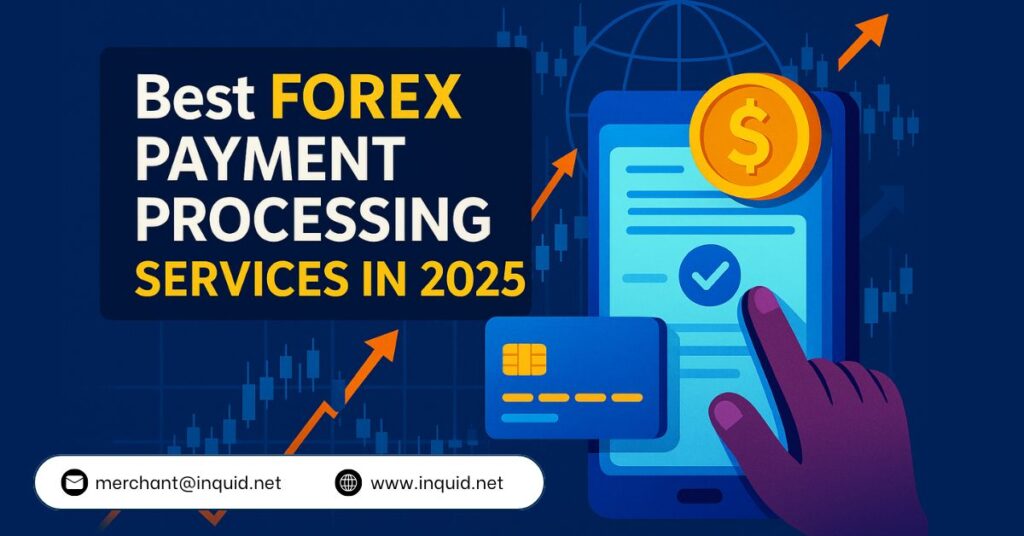
Processing payments in the forex industry has never been a one-size-fits-all solution. Between international regulations, risk classifications, and high transaction volumes, choosing the best forex payment processing services requires more than just a competitive rate. In 2025, forex businesses are leaning on providers that offer reliability, fast settlement, chargeback tools, and strong global banking connections.
Why Forex Merchants Need Specialized Processors
Forex merchants deal with multi-currency transactions, volatile volumes, and customers across regions with varying regulations. This puts them in the high-risk category for most banks. To operate smoothly, they need the best forex payment processing services, as standard merchant accounts often fall short.
Choosing a provider that supports cross-border compliance and risk tolerance is essential. If you’re not working with a processor that understands the challenges of forex transactions, you’re more likely to face account holds or sudden terminations.
If you’re new to the market or scaling globally, take time to understand the forex merchant account process from setup to settlement, so you’re not caught off guard by hidden conditions or slow payouts.
Features to Look for in a Forex Payment Processor
Not all processors are equipped to handle the unique requirements of forex trading platforms or brokers. Here’s what sets the best apart in 2025:
1. High Approval Rates for High-Risk Industries
Look for processors with a track record in approving high-risk businesses. These companies typically have stronger relationships with acquirers that don’t shy away from forex or crypto.
2. Chargeback Management Tools
The best providers now offer built-in chargeback prevention and dispute tools. This is critical, considering how often transactions in the forex space can be reversed. It helps to choose a provider that integrates chargeback control into your payment gateway so you’re not losing revenue to friendly fraud.
3. Fast Settlement and Currency Support
For forex brokers operating globally, receiving payments quickly and in the right currency can affect everything from liquidity to trader trust. Many of the leading services in 2025 offer multi-currency accounts and faster settlement cycles—often within T+1 or T+2 timeframes.
4. Security and Compliance
You’re not just dealing with financial risk—you’re also managing data risk. Compliance with PCI DSS, PSD2, and local AML/KYC regulations is critical. Before you pick a provider, make sure they understand compliance risks in global payment processing and actively help mitigate them.
Top Forex Payment Processing Services Worth Considering
While the market continues to shift, here are some types of processors standing out this year:
Independent Payment Service Providers (ISOs)
ISOs with high-risk experience can often get forex businesses onboarded faster. They have more flexible underwriting criteria and multiple acquirer options, giving you access to better routing and fewer rejections.
Crypto-Compatible Processors
Some forex brokers accept cryptocurrency deposits to bypass traditional bank delays. Processors that support fiat-to-crypto conversion and crypto wallets are growing in popularity, especially among platforms targeting Asia and Latin America.
High-Risk Merchant Service Specialists
Providers that cater to forex, gaming, and adult businesses typically offer more resilient infrastructure. Their tech stacks are designed for fraud detection, risk scoring, and volume fluctuations. If you operate across multiple verticals, consider those that already support credit card solutions for forex and related industries.
Choosing the Right Fit for Your Business Model
No two forex businesses are alike. Whether you run a trading platform, affiliate site, or education portal, your payment processing needs will differ. When comparing providers, ask yourself:
- Do they offer dynamic currency conversion?
- Are settlement cycles fast enough for your payout model?
- Is there a transparent fee structure?
- What fraud prevention tools are included?
Also, consider whether your provider offers dual accounts—one for cards and another for alternative payment methods like e-wallets or crypto. This can reduce declines and improve customer experience in regions with limited card usage.
Final Thoughts
Forex is fast-moving, and so are the risks. In 2025, payment processing for forex isn’t just about getting paid—it’s about staying compliant, competitive, and prepared. Work with providers that understand your business model, your risk profile, and your growth plans. And remember, the right partner won’t just process your transactions—they’ll protect your revenue.
FAQ: Forex Payment Processing in 2025
Q1: Why is forex considered high-risk by payment processors?
A: Forex involves high transaction volumes, chargeback risks, and regulatory scrutiny, making it riskier for banks and acquirers.
Q2: Can I use a standard payment gateway for forex transactions?
A: No, forex typically requires a high-risk merchant account with specialized gateways designed for such industries.
Q3: How can I reduce chargebacks in forex?
A: Use providers that offer automated dispute management and chargeback alerts. Also, maintain transparent transaction records and customer communication.
Q4: What’s the best settlement cycle for forex?
A: T+1 or T+2 is ideal for liquidity. Slower cycles like T+7 can affect trader trust and business operations.
